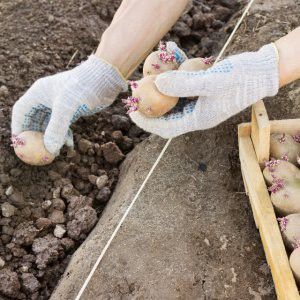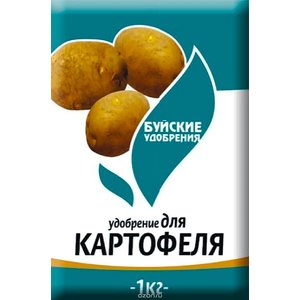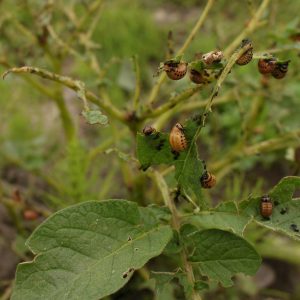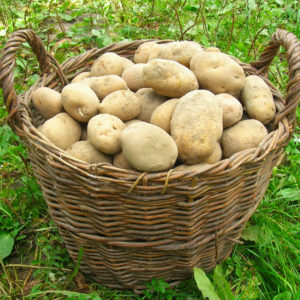Step-by-step recommendations: how to grow potatoes from A to Z
Potatoes are an essential ingredient in many dishes and have a high nutritional value. Although it is grown by many gardeners, not all of them are ready to boast of a rich and high-quality harvest. When cultivating a vegetable, it is important not only to observe the basic techniques of agricultural technology, but also to know some tricks.
What methods of growing potatoes exist and what to pay special attention to when planting and caring, read on.
The content of the article
Potato planting dates
Cultivation of crops in open ground implies compliance with the basic rules of agricultural technology. Particular attention is paid to the timing of planting potatoes. It is planted in the spring when the soil temperature reaches + 10 ° C at a depth of 15 cm and the threat of cold snaps passes.
Specific terms depend on the region:
- southern regions - late March or early April;
- regions with a temperate climate - the second half of April;
- northern strip - early May.
Some summer residents lay potatoes in the ground, taking into account the maturation of the tubers. Early varieties are planted 2 weeks earlier, and mid-season and late ones - according to the schedule indicated above.
Many gardeners take into account the indicators of the lunar calendar. Plants are planted during the waning moon. For 2020, the schedule is:
| Month | Unfavorable days | Auspicious days | Neutral days |
| April | 3-4, 9, 15–17, 20–22, 29-30 | 1-2, 7-8, 10, 14, 23-24, 28 | 5-6, 11–13, 18-19, 25–27 |
| May | 8, 14, 29 | 2-3, 5, 7, 11-12, 15-16, 25-26 | 1, 4, 9-10, 13, 17, 24, 27-28, 30-31 |
| June | 21, 29 | 1–5, 8, 12, 18, 22, 25 30 | 6-7, 9–11, 19-20, 24–28 |
Important! If you plant potatoes at an unfavorable time, then the seedlings will appear for a long time and there will be a threat of the death of the crop.
Preparing for landing
To speed up the emergence of seedlings, increase the germination of planting material and make plants resistant to diseases and weather conditions, it is important to properly prepare the tubers for planting.
Phased preparation:
- Calibration. The tubers are sorted out, all damaged specimens with traces of diseases are removed. Then sorted by size. Egg-sized potatoes are ideal for planting.
- Disease treatment... It is carried out in two stages: first, the tubers are soaked in a light pink solution of potassium permanganate or in copper sulfate (1 tsp of powder per 1 liter of water). Then it is washed with a solution of boric acid (0.5 tsp of powder is taken for 3 liters of water). After each step, the vegetables are dried.
- Growth stimulation. The planting material is soaked for half an hour in a growth stimulator, for example, "Solution". The potatoes are then allowed to dry completely.
- Germination.
- Hardening. The planting material is taken out for 2 days in a room with a temperature of + 10 ... + 12 ° C.
Methods germination (vernalization) tubers:
- Potatoes are placed in one layer in a bright room with a temperature of + 12 ... + 20 ° C. Until sprouts appear, it is regularly sprayed with warm water.
- Tubers are laid out in one layer on the street or on a balcony in a bright place, sprinkled with a layer of peat or straw. If the temperature drops, the planting material is additionally covered with a film.
- Vegetables are placed in one or more layers in wet sawdust, burlap or peat. During germination, a sufficient level of substrate moisture is maintained.
- A hole is dug 20 cm deep, a layer of compost is poured into it, planting material is laid out on top and covered with a layer of earth.
Often potatoes are planted whole, but to save money, they are cut into several parts so that a sprout remains on each of them.
By the way! To quickly "awaken" the tubers, they are wilted for 7–10 days in a warm, bright room at a temperature of + 15 ... + 20 ° C. After that they are heated for 3-4 days at + 30 ... + 35 ° C. This accelerates the germination of the eyes, increases the yield of the crop.
Site preparation

Potatoes are grown without seedlings, so only the soil in the garden is prepared.
The culture loves light nutritious soils. An excellent option is black soil. Heavy earth is diluted with sand. Solanaceae love slightly acidic soils. In the soil with high acidity, the culture will also grow, but the yield will decrease, and the likelihood of being damaged by pests will be higher. If the acidity is lowered, make ash or dry lime (1 tbsp. Per 1 m2).
Seat selection
Potato - light-loving plant... Well-lit areas of the garden are suitable for him. The groundwater in the selected location should not be too close to the surface.
The potato bed should not have grown nightshade crops in the past 2 years. Good predecessors: melons, legumes, greens, cabbage, carrots.
On the site, the rules for the competent neighborhood of plants are observed. Other nightshades are not planted nearby to avoid damage by diseases and pests.
Fertilization
In the fall, the beds are dug up and cleaned of weeds. 6 kg of humus or cow dung are introduced into the soil for each 1 m2. Additionally, the collected plant remains are cleaned from roots and seeds, the rest of the parts are crushed and buried in the ground.
In the spring, the soil is dug up again and cleaned of weeds. Ash (1 st. Per 1 m2), superphosphate (25 g per 1 m2) and urea (15 g per 1 m2) are added to the ground. All fertilizers are mixed with soil.
Important! The beds are watered with a hot solution prepared from 1 bucket of water and 1 tbsp. l. copper sulfate.
A handful of ash is poured into each potato hole. Some vegetable growers use long-acting granular mineral fertilizers.
Landing schemes and technology
For the cultivation of crops, different schemes are used. In all cases, immediately after planting, the beds are watered with water at room temperature. At night, the first 2 weeks, the site is covered with a film. For planting and caring for potatoes in the open field on a large area use the walk-behind tractor "Cascade" and other equipment.
The list contains the most popular potato growing technologies.
Classic technology
They make beds 20 cm high and 160 cm wide. 30-50 cm are left between them. 2 rows of potatoes are planted on each hill, keeping a distance of at least 80 cm between them.
Dutch scheme
If the groundwater is close to the soil surface, potatoes are planted in ridges. The rows are placed at a distance of 75 cm from each other, a gap of 50 cm is made between the holes. Humus and ash are poured into each groove, after which they are laid on a tuber.
Sprinkle potatoes with earth on both sides, forming a ridge. As it grows, the earth is poured, weeds are removed. As a result, elevations reach 30 cm. This scheme is called Dutch.
Under the shovel
Shoveling is the most popular and ancient method. For each tuber, dig a recess of 6-10 cm. Potatoes are thrown into the hole, 1 tbsp. l. ash or granular long-acting fertilizers are covered with earth.
The disadvantage of this method: the sensitivity of the vegetable to high humidity with a shallow planting.
Under the straw
Caring for potatoes makes it easier to grow under straw. To do this, the tubers are laid out in one row on a moistened dug-up bed, at a distance of 25-30 cm from each other. The planting material is sprinkled on top with a thin layer of earth and a 20 cm layer of straw. In this case, it is not necessary to mulch and loosen the beds.
The only negative is that the straw attracts slugs and rodents.
Under mulch
When cultivating under mulch, sawdust, humus or peat are used. Planting scheme, like under straw.
In bags, boxes or barrels

Growing potatoes in bags, crates, or barrels is easy. For this, a container of 20 cm is filled with a mixture of garden soil and compost.Then 3-4 sprouted tubers are laid, which are covered with earth.
When the height of the bush reaches 15 cm, add 6-7 cm of earth. This is done several times. This method allows you to get a rich harvest without weeding, mulching and hilling. It reduces the risk of plant rot and blight disease.
Chinese scheme
The Chinese method excludes hilling and mulching. For this, holes are dug in a checkerboard pattern 50 cm deep and 70 cm wide. 6 cm of fertile soil is poured at the bottom, potatoes are laid. Sprinkle 6 cm of soil on top of the tubers.
When the plant reaches a height of 15 cm, so much soil is poured into the hole so that the stem is half closed. This is done until the holes are filled, and hills 10 cm high are not formed above the surface of the plot. The preparation of the planting holes is a rather complicated process that gives the highest yields.
Deep landing
With deep planting, pits are dug 15–20 cm below the soil level, sprouted and processed potatoes are laid out with sprouts down, and 2-3 cm of wet earth are sprinkled on top. This option is suitable for arid regions.
Meatlider method
They make beds in the direction from north to south 50 cm wide. A distance of 1 m is left between them. Potatoes are buried 10 cm in 2 rows. A trench 5 cm deep is made between the rows, water and fertilizers with magnesium, molybdenum, potassium, nitrogen, phosphorus and boron are poured into it. This is a costly method, but it increases yields by an order of magnitude.
In the trenches
Planting in trenches will allow you to get a rich harvest and do without feeding. In autumn, trenches are dug 30 cm deep at a distance of 70 cm from each other. They are filled to a height of 15 cm with straw, plant residues, 25 g of urea are poured for each 1 m2. Additionally, 1 tbsp is applied per 1 m2. ash. In the spring, tubers are laid in the grooves, which are sprinkled with earth.
Top dressing
Fertilizers are applied to all phases of potato development. Mineral and organic compounds are alternated, they are used 3-4 times per season:
- 2 weeks after germination;
- when the first bud is formed;
- during the period of mass flowering.
Additional formulations are used depending on the specific conditions: if the potato is planted in poor soil or has signs of nutritional deficiency (sluggish leaves, reddish veins, and others), add another top dressing.
Home remedies for fertilizing potatoes are the safest:
- Chicken droppings or mullein are diluted 1:10 with water. Add 15 g of urea to the bucket. Under each bush, 1 liter is applied.
- In a bucket of water, dilute 1 tbsp. ash, 15 mg potassium sulfate and 30 mg superphosphate. Pour 1 liter of the product under each bush.
- Onion husks and compost are used to enrich the soil: they mulch the beds or water the crop.
- The bucket is 2/3 filled with nettles or other weeds without roots and seeds. The rest of the space is filled with water at room temperature. The mixture is infused for 10 days. For 1 liter of the resulting composition, take 5 liters of water. Consumption: 1 liter per 1 bush.
Used in potato growing and purchased fertilizers, which are bred according to the instructions:
- Nutrivant Plus;
- "Code Zn-L";
- "Hera".
Potato care
Consider how to properly care for potatoes. To do this, follow the basic agrotechnical techniques:
- Loosening. Before the first shoots appear, this is done 2-3 times to ensure normal air exchange. Further loosening is carried out after watering.
- Weeding. In beds with young plants, weeds are constantly removed. When the bushes grow up, they will cope with them on their own.
- Hilling. This is an indispensable step in growing potatoes, allowing you to get a rich harvest. The soil is raised by 6 cm 3 times per season. For the first time, the bushes are spud when they reach 15 cm, then 2-3 weeks before the buds appear and as the potatoes grow up to 20-25 cm in height.
- Watering. In dry summers, the plantings are moistened once every 2 weeks.Up to 3 liters of water are consumed per bush. Watering is not necessary during the rainy season.
Mulch the soil when planting or in the fall.
Diseases and pests
Basic preventive measures:
- compliance with the rules of crop rotation;
- treatment of the culture after cold snaps with antifungal agents (Fitosporin, light pink solution of potassium permanganate);
- disinfection of soil, planting material and garden tools;
- compliance with the irrigation regime;
- timely introduction top dressing.
Potatoes attack a variety of diseases. The most common ones are:
- Late blight... Tubers develop hard or gray spots that spread throughout the plant. Leaves wilt and turn black.
- Potato cancer... Discoloration and swelling are characteristic of the tubers and the ground part of the bush. Later, dark growths form.
- Dry spot... The greens are covered with dark brown spots, which soon dry out. Holes appear in the leaves.
- Alternaria. The tubers are covered with round, depressed spots, and the leaves are covered with black formations.
- Infectious wilting. This is a group of diseases in which the ground part of the bush withers. Brown or brown spots appear on the tubers.
Fungicides are used against the fungal diseases listed in the list. Viral infections are not cured.
Important! Potatoes are more difficult to cure than other plants, since the disease affects the tubers that are in the ground.
Harm to culture and insects:
- Colorado beetles... They eat potato greens. Remove pests by hand. The dusting of leaves with ash or special preparations ("Barrier") help.
- Wireworms... These are the larvae of click beetles that eat tubers. For prevention, the soil is poured with boiling water before planting vegetables, a weakly acidic environment is created.
- Cicadas. They look like aphids, feed on the juice of potato leaves. Dry brown spots are formed in places of damage. Chemicals are used against insects (for example, "Karate Zeon").
- Potato fleas... Adults infect greenery, and larvae attack the root system. This leads to wilting of the bush. To control pests, plantings are sprayed with 0.2% phosphamide.
Harvest time

Potatoes are dug up from late August to mid-September, when the tops wilt. Approximate terms for early varieties - 80 days, mid-ripening - 100 days, late - 120 days.
Tubers are harvested in dry, sunny weather to keep the harvest clean. Use a pitchfork to avoid damaging your vegetables. Store in a cool, dark, dry place in fumigated gray boxes.
Tips & Tricks
Experienced growers give some more tips on how to grow potatoes:
- During frosts, the bushes are completely huddled to protect them from death.
- 2 weeks before harvesting, the plantings are sprayed with a superphosphate solution: 25 g per bucket of water. This will improve the taste of the tubers.
- To avoid weeding, cover the beds with a layer of hay or straw.
Conclusion
Cultivation of potatoes is a simple process that does not require a lot of effort and time. It is important to huddle the plants in a timely manner, feed them, observe the irrigation regime and the rules for the prevention of diseases. Use the recommendations from our article, and a rich harvest is guaranteed for you!